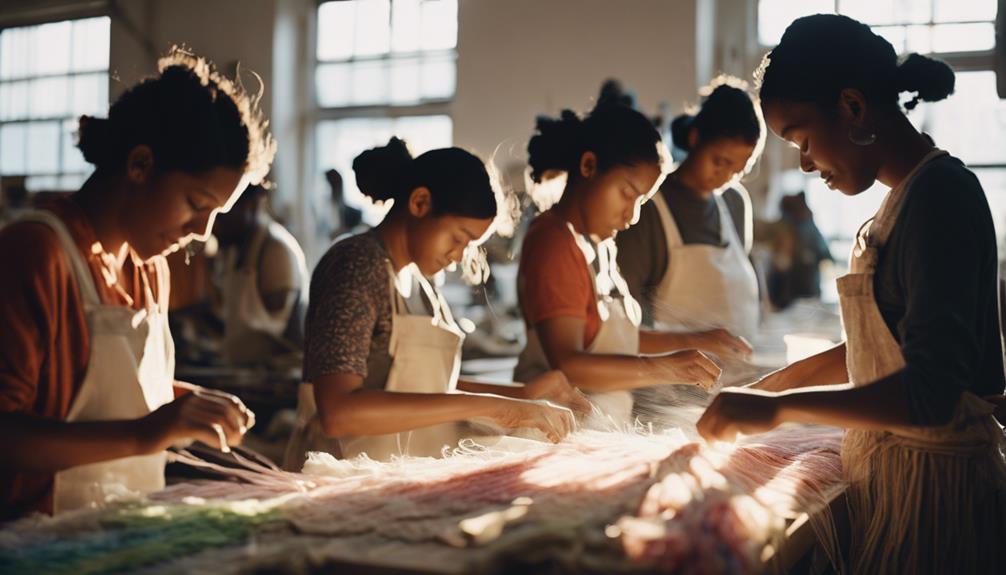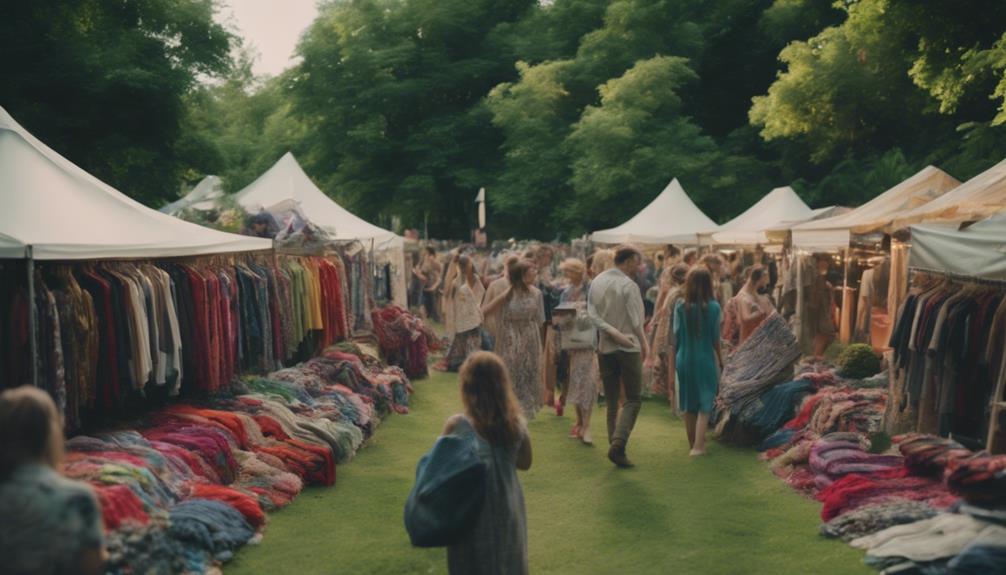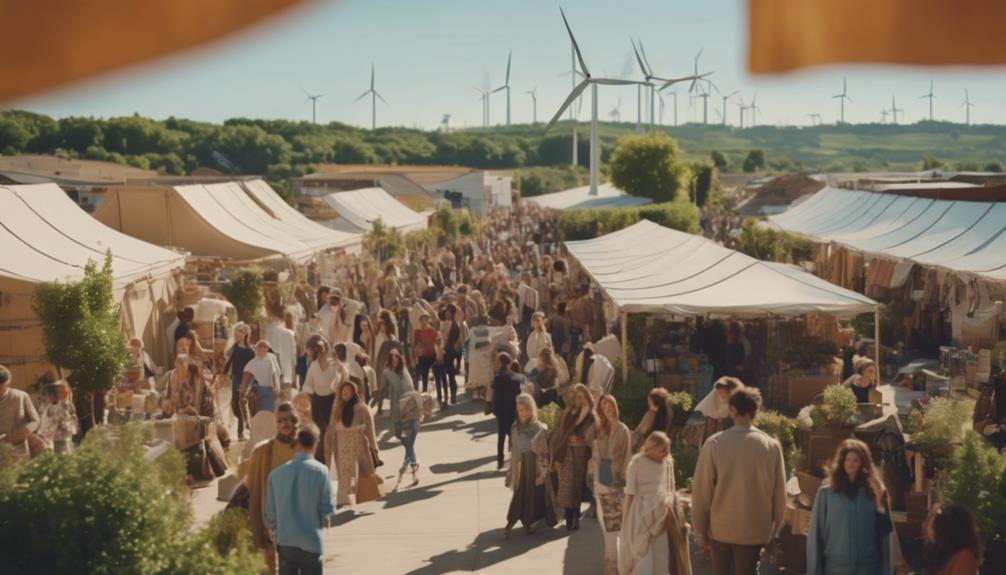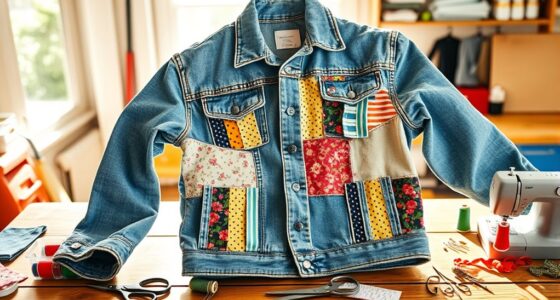Sustainable fashion is not just about changing wardrobes; it is about transforming the economy. By supporting eco-friendly brands, you not only increase their sales but also contribute to job creation in industries such as recycling and ethical production. This movement encourages a circular economy, which helps to reduce waste and lower costs for businesses, while also addressing the $500 billion loss from unused clothing. Furthermore, as consumers demand more responsible options, brands experience a rise in market value and customer loyalty. As sustainability becomes more popular, you may find the economic ripple effects to be more fascinating than expected. There is still much to learn about how these practices are reshaping our world!
Key Takeaways
- Sustainable fashion increases consumer demand for eco-friendly products, boosting sales and market value for brands prioritizing sustainability.
- The sector is projected to create 30% more jobs in recycling and sustainable production over the next decade.
- Emphasizing a circular economy reduces waste and resource consumption, saving costs and enhancing economic efficiency.
- Ethical sourcing and fair wages improve working conditions, supporting community well-being and economic stability.
Economic Growth of Sustainable Fashion
Sustainable fashion is driving economic growth as consumers increasingly seek eco-friendly products, boosting sales and market activity. You might've noticed a shift in your shopping habits, gravitating towards brands that embrace sustainable practices. This trend isn't just a fad; it reflects a strong demand for ethical fashion, which prioritizes environmental responsibility and social equity.
As you choose to support these brands, you're contributing to a circular economy, where products are designed to last, be reused, and recycled. This approach not only reduces waste but also enhances global economic efficiency. When brands invest in sustainable practices, they often see a surge in market value. This indicates that prioritizing sustainability can lead to profitability, proving that eco-friendly choices can be financially viable.
Moreover, the increasing consumer consciousness around sustainability is stabilizing the economy. As more people shift their spending towards responsible brands, it creates a ripple effect, encouraging others to adopt similar practices. By aligning your purchasing decisions with sustainable fashion, you're not just making a style choice; you're actively participating in a movement that promotes economic growth and environmental health.
Production and Labor Practices

Ethical production and labor practices in fashion not only support workers' rights but also foster economic growth and community well-being. When you choose sustainable fashion, you're making a positive impact through the production process and the treatment of workers. Here's how:
- Fair Wages: Sustainable fashion promotes fair wages, ensuring workers have the economic stability to support their families and communities.
- Better Working Conditions: Ethical sourcing improves working conditions, reducing exploitation and contributing to a healthier, more productive workforce.
- Community Development: By supporting local artisans and manufacturers, sustainable fashion strengthens community ties and enhances overall quality of life.
- Increased Market Value: Brands that prioritize ethical labor practices often see a rise in market value as consumers increasingly demand transparency and responsibility in their purchases.
Circular Economy Model

The circular economy model in fashion redefines how you think about clothing by prioritizing reuse, recycling, and waste reduction. This approach greatly lowers the environmental impact of the fashion industry. By extending product life cycles, you're not just reducing resource consumption; you're also encouraging sustainable clothing practices that benefit the planet.
Implementing circular practices can save money too. Studies show that about 55% of emission-reduction strategies could lead to cost savings for brands. Instead of relying on non-biodegradable fabrics, the circular economy promotes materials that can be recycled or reused, which helps decrease the staggering 92 million tons of textile waste generated annually.
Innovative product design and manufacturing processes are crucial in this model. As you engage with brands that embrace these principles, you open doors to new market opportunities. Collaborative efforts among consumers, brands, and governments can amplify these benefits, leading to a more sustainable and economically stable fashion industry.
Global Economic Impact

Sustainable fashion isn't just a trend; it creates significant economic ripple effects.
When brands adopt eco-friendly practices, they save on waste management costs and foster collaboration that benefits the entire industry.
You'll see how these changes not only boost profits but also encourage a healthier economy overall.
Economic Ripple Effects
How might the rise of eco-friendly fashion reshape global economies and drive new growth opportunities? The sustainable fashion movement is creating a ripple effect that influences various economic sectors.
Here are four key ways it impacts the economy:
- Job Creation: As brands adopt sustainable practices, new roles in recycling, upcycling, and sustainable production emerge, boosting employment rates.
- Reduced Waste Costs: By embracing a circular economy, companies minimize clothing underutilization, cutting financial losses that exceed $500 billion annually.
- Enhanced Economic Efficiency: Sustainable practices streamline operations, lowering waste management costs and promoting resource conservation across industries.
- Collaborative Growth: Partnerships between brands to promote eco-friendly initiatives can lead to widespread economic benefits, further enhancing community resilience.
Waste Management Cost Savings
Embracing sustainable fashion practices not only creates jobs but also leads to considerable waste management cost savings that can reshape local economies. When you adopt these practices, you're directly contributing to less waste generation. This means lower expenses for disposal and recycling services, which can be a burden on local budgets.
Transitioning to a circular economy in fashion is projected to decrease landfill waste, translating into cost savings that enhance economic efficiency in municipalities handling textile waste. By minimizing non-biodegradable fabric use, sustainable fashion alleviates the financial strain on waste management systems, which often struggle with high costs associated with processing synthetic materials.
Moreover, these initiatives reduce the need for extensive waste management infrastructure upgrades. This allows cities to allocate resources to other essential services and community projects. The financial benefits of reduced waste management expenses can positively impact local economies, as those savings can be redirected towards community services and green initiatives.
In short, embracing sustainable fashion not only benefits the environment but also considerably cuts waste management costs, paving the way for healthier local economies.
Collaborative Brand Benefits
Collaborating with other brands in the sustainable fashion sector boosts economic growth by cutting costs and enhancing profitability through shared resources and innovative practices.
When you engage in collaborative efforts, you help create a sustainable future and reap several economic benefits:
- Cost Reduction: Shared resources lead to lower waste management expenses and resource depletion costs.
- Job Creation: Sustainable practices foster job growth, contributing to economic stability in communities focused on ethical production.
- Increased Market Value: Brands that prioritize eco-friendly options often experience higher sales and stronger brand loyalty as consumers demand more sustainable products.
- Efficiency Improvements: Partnerships promote innovative solutions that enhance overall efficiency, reducing reliance on virgin materials and lowering production costs.
These collaborative efforts not only minimize landfill waste but also create a ripple effect within the economy.
As you invest in sustainable practices, you contribute to a circular economy that benefits both businesses and consumers.
Future Trends in Sustainable Fashion

As consumer demand for eco-friendly products rises, the sustainable fashion market is set to undergo significant transformations that prioritize innovation and responsibility.
You'll notice that brands are increasingly focusing on sustainable products, incorporating biodegradable fabrics and advanced recycling technologies into their offerings. This shift not only enhances sustainability but also raises industry standards.
Moreover, the principles of the circular economy are gaining traction, encouraging brands to adopt business models centered around reuse, recycling, and waste reduction. By doing so, they're not just minimizing their environmental impact but also creating a more resilient economic framework.
As a consumer, your choices play an essential role in this evolution; when you support sustainable brands, you contribute to their growth and influence market values positively.
Expect to see greater collaboration between consumers and brands as this emphasis on sustainability deepens. Together, you can foster a collective effort towards a responsible and environmentally friendly fashion industry.
In this exciting landscape, the future of sustainable fashion looks bright, driven by your demand for better practices and products. Embrace this shift, and you'll be part of a movement toward a more sustainable world.
Definition and Importance

Sustainable fashion isn't just about being eco-friendly; it offers significant opportunities for economic growth and job creation.
By shifting focus to sustainable practices, you can tap into a global market that's increasingly demanding responsible products.
Embracing this trend can enhance your brand's value and influence in the fashion industry.
Economic Growth Potential
Economic growth potential in the sustainable fashion sector lies in its ability to meet rising consumer demand while fostering innovation and resource efficiency. As more consumers prioritize sustainability, the fashion industry is adapting, driving economic growth through various avenues:
- Increased Sales: Sustainable brands are witnessing a surge in market values as consumers gravitate towards eco-friendly options.
- Resource Conservation: An estimated $500 billion is lost annually due to clothing underutilization, showcasing the need for better resource management.
- Cost Savings: The circular economy model promotes longer product life cycles, reducing waste management costs and enhancing efficiency.
- Innovation Opportunities: Growing consumer awareness fosters a fertile ground for innovative solutions in sustainable practices.
Job Creation Opportunities
Job creation in the sustainable fashion sector is crucial, not only for boosting the economy but also for fostering ethical practices and community well-being. As the demand for eco-friendly products continues to rise, jobs in sustainable fashion are projected to increase by 30% over the next decade. This growth reflects a shift towards more ethical production practices, offering stable employment opportunities for many.
Sustainable brands often prioritize fair wages and improved working conditions, which can greatly enhance job stability in communities that depend on fashion production. Furthermore, the circular economy model, which promotes recycling and upcycling, is creating new job opportunities in repair, resale, and recycling industries.
When you invest in sustainable fashion, you're not just supporting eco-friendly practices; you're also contributing to economic benefits. Businesses that adopt these practices tend to see increased market value and greater consumer loyalty.
Global Market Influence
The global market influence of eco-friendly fashion is reshaping industry standards and driving innovative practices that prioritize both ethics and sustainability.
As you consider this transformation, think about how sustainable fashion not only impacts the environment but also enhances the economy in significant ways:
- Increased Sales: Consumer demand for sustainable products is skyrocketing, boosting sales for brands committed to eco-friendly practices.
- Market Share Growth: Sustainable fashion is projected to capture a larger portion of the global fashion industry, reflecting changing consumer preferences.
- Cost Efficiency: By adopting sustainable practices, brands can reduce operational costs; about 55% of emission-reduction strategies can save money.
- Local Economic Support: Investing in sustainable fashion promotes fair wages and better working conditions, fostering economic stability in communities.
This shift isn't just about style; it's a powerful movement toward a more responsible global fashion industry.
Transitioning to Sustainable Practices

Shifting to sustainable practices demands actionable commitments from businesses, moving beyond slogans to implement real change in production and sourcing methods. You need to collaborate with clients, manufacturers, and distributors to guarantee that every part of the supply chain engages in this change.
While adapting to sustainable models can be challenging, embracing eco-friendly practices offers significant growth potential for your business. As consumers become more conscious of their shopping habits, the demand for slow fashion increases. They're looking for brands that prioritize ethical sourcing and sustainable packaging.
By responding to this shift, you can't only meet consumer expectations but also enhance your brand's reputation and loyalty. Assistance is available to help you navigate the complexities of implementing sustainable practices. From ethical sourcing to innovative packaging solutions, support covers all production stages.
Frequently Asked Questions
How Does Sustainable Fashion Affect the Economy?
Sustainable fashion reshapes the economy by reducing waste and promoting ethical practices. You'll find it boosts brand reputations, supports fair wages, and encourages innovative business models, ultimately leading to financial benefits for the industry.
How Does Sustainability Affect Fashion?
You might think sustainability limits creativity in fashion, but it actually inspires innovation. By embracing eco-friendly practices, you'll discover unique designs, reduce waste, and contribute to a healthier planet, all while staying stylish and relevant.
What Is Sustainable Fashion and Why Is It Important?
Sustainable fashion focuses on eco-friendly practices, prioritizing quality and durability. It's important because it reduces waste, protects ecosystems, and lessens carbon emissions. You're contributing to a healthier planet by choosing sustainable clothing options.
Is Sustainable Fashion Good or Bad?
Sustainable fashion's good for the planet and society. It promotes ethical practices, reduces waste, and encourages innovation. You'll find it supports healthier communities while offering stylish choices that align with your values.
Conclusion
In a world where fast fashion thrives, sustainable fashion emerges as a beacon of hope.
While quick profits lure many, the long-term benefits of ethical production and responsible consumption pave the way for genuine economic resilience.
Embracing sustainable practices not only fosters innovation but also revitalizes local communities.
As you navigate this evolving landscape, remember: choosing sustainability isn't just a trend—it's an investment in a thriving economy and a healthier planet for future generations.









